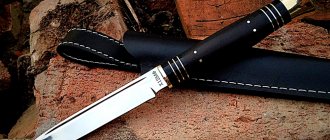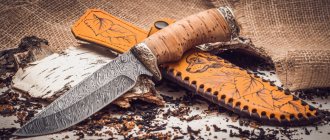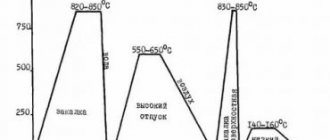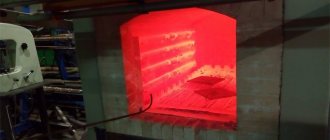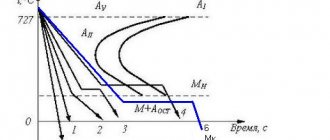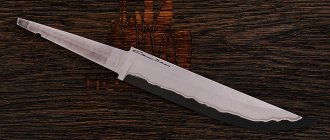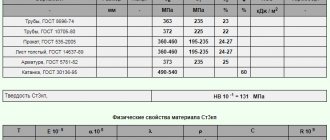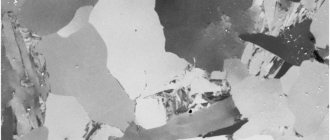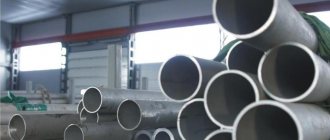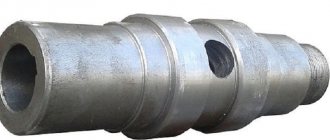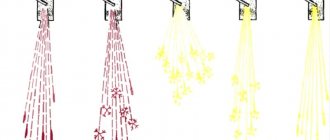Features of steel
The main products made from X12MF alloy are knife blades. And the specific addition of metals to the alloy determines its place of application. For example, chromium is added to the alloy discussed in this article. As a percentage of other metals in this grade, steel is only twelve percent.
Many people are interested in whether X12MF steel rusts or not. Yes, the knife is prone to rust in the kitchen, where the knife will constantly be in dampness, it has no place .
X12MF steel is more suitable for hunters. Since the addition of chromium increases the wear resistance and cutting properties of the product.
With proper care, X12MF will not rust for quite a long time. And the decoding of the name of the metal alloy means the following:
- X – addition of chromium, where the number 12 means its percentage among all other metals;
- M – it contains molybdenum;
- F – vanadium.
Heat treatment of steel X12MF
So that the tool “holds the tip” well, so that the cutting edge does not crumble, and ideally it would be nice if the hardness of 61-62 HRC was combined with relative viscosity (so that it does not burst).
Why do you need 61-62 for tin ? As I understand it, the hardness there is no higher than 130-150HB? For such hardness, 59-60 is beyond your eyes (since you need impact strength). In fact, it is very difficult to defend your point of view in a reasoned manner
? As I understand it, the hardness there is no higher than 130-150HB? For such hardness, 59-60 is beyond your eyes (since you need impact strength). In fact, it is very difficult to defend your point of view in a reasoned manner
without a bunch of references to reference literature on thermals, critical points, etc.
.
For X12MF, “Marochnik” Sorokina recommends hardening from 1010-10300, and after tempering 2000 1.5 hours, the hardness is 63HRC, and sp. viscosity (KCU) 43 J/cm2, then after tempering 3000 1.5 hardness 61HRC, and KCU) 64 J/cm2 - decide for yourself whether a couple of hardness units is worth one and a half changes in impact strength! This edition is from 2001 - not on this site, there is an older edition here -
In order not to torment you, in addition to this brand, I will give links to just one (but very good) book, which can be downloaded here:. Unfortunately, there is no data there for X12MF, because... the book is old - available for X12M and X12F1; X12MF is closer in properties to X12M.
Choice of hardness: pp. 39-42, also Fig. 13 (p. 35). Pay special attention to Fig. 18 (p. 41) - with a large amount of retained austenite, the die will quickly “sit down” even at high hardness! Roughly speaking, in order for the stamp not to shrink, you need a compression yield strength of the stamp higher than the hardness of the material being processed (do not forget that tin with the initial 110-150HB during stamping can be riveted up to HB = 200-220 kg/mm2 = 1960-2150 MPa !
As can be seen from Fig. 183a, the hardness is maximum when quenched from 10300, and at 1000 and 10500 it is 1HRC lower - but from Fig. 182b it is clear that at 10000 the steel has 17% residual. austenite, and at 10500 - as much as 28%, so, based on Fig. 18, hardening from 10000 is much better. In this regard, cold treatment is very useful (in this case it is better to heat from 10500), but the impact strength is noticeably reduced! Another method is hardening from 11000 and repeated (at least three times) tempering at 5200 (Fig. 183b) - after each new tempering, part of the residue disintegrates. austenite, and the hardness increases - this is the so-called. “TO for secondary hardness” - according to the same principle as for a quick cutter (see pp. 351-353). After the 3rd holiday it will be 63Rc, with only 3-4% remaining. austenite - so the stamp will “shrink” very slowly, but it may crumble - again, the impact strength with such maintenance is reduced! Data on the strength and impact toughness of the closest aalogs at different tempering temperatures are from the same Geller in Fig. 187-188 (p. 298-299), and the words “hardening to fine grain” in Fig. 188 most likely mean 980- 10200, as indicated in the text below the figure.
You can increase impact strength by thermal cycling (TC) - what Sergey 7 advised you:
Show the brochure to the thermal engineer https://www.chipmaker...iles/file/2131/
There, in fact, there is only one recommendation for this steel - double quenching in oil (the first from 9500, the second from 10000, tempering 1800); Impact strength supposedly increases by 1.5 times. On knife forums, thermally cycled X12MF is offered under the commercial sign “wave steel” - you can google “wave steel reviews.”
And now, as SDF wrote, about the main thing:
In order to get closer to the German quality of the tool, you need to have German steel quality. Due to the fact that the quality of this steel is very often bullshit, you have to work magic on it, and often to no avail. There is such a thing called carbide heterogeneity. In this steel, if the carbide heterogeneity (unevenness) does not correspond, in other words, if as a result of forging the technology was not followed and the carbides were not evenly distributed throughout the structure and they collected in the steel in heaps and heaps, the heat engineer can suffer for at least a year with such steel, nothing It won’t do any good and no amount of annealing will break these carbides, they’re all in trouble. And then our tool can crack, crumble, not hold the tip and anything and everyone will swear at the unfortunate thermal operator, and these carbides can be distributed evenly throughout the structure, only additional forging. First check the steel for quality, then heat it. First, read the GOST for this steel; if the carbide heterogeneity is high, return the workpieces back to the manufacturer, you will not achieve anything from them - this is already a defect.
Let me add: any manufacturer complies with GOST, but a good manufacturer has better carbide heterogeneity than Gostov (and it must be indicated in the quality certificate; if it is not indicated, like some “Petrostal”, it means 100% crap!). Of course, a score of 1-1.5 for such steels is achievable only with powder technology, and this is quite expensive (for Geller, see Fig. 266, p. 388); for pipes (by the way, why don’t you use a thick-walled pipe for parts with an internal hole? It would be much more economical!) Radial shear rolling (RSP) is very effective - but for a circle it creates an almost ideal structure at the surface, and in the core there is almost no improvement.
About the influence of carbide heterogeneity and the fight against it - see pp. 164-190 ( how strongly carbide heterogeneity affects the strength of steel and service life - see table 25 ( p. 172) and Fig. 100 (p. 178) ; there data for P18, but for X12 and its analogues they are very, very similar); As can be seen from these data, very, very much depends on the OMD method - and which manufacturer has what OMD method - you need to read on their own websites. The easiest way is to focus on the quality certificate (there, as I already wrote, carbide heterogeneity should be indicated) .
What about X12, etc. on this matter, read Geller paragraph 73 (pp. 307-311). Annealing at 1160-11800 can slightly reduce carbide heterogeneity; 2-3 min/mm - we are talking about the so-called. given diameter, for you - the lid punch 2 hours, the rest of the parts - 1 hour is enough. But in general, the longer, the better (from myself: in general, 1200-12200 is much better, but first you need to keep it at 1160-11800 for a couple of hours, then at 1180-12000 for a couple of hours and only then heat it to 1200-12200 - otherwise may simply fall apart; that’s why Geller doesn’t write about such a complex regime - because technological discipline in our country is lame, and the number of assholes who are trying to do something faster when it can’t be done is off the charts!)
“Preliminary heat treatment” - this is important for dies of complex shapes; in yours, the transfer pricing is better.
About:
You can find Kh12MF steel purified by electroslag remelting.
- This is good in the chemical sense. composition (again: in GOST the purity requirements for sulfur and phosphorus are very low, this is important for impact strength), but it has little effect on carbide heterogeneity. Here, OMD is more important (but ESR is also quite harmless: in this case, the steel will be marked as Kh12MF-Sh)
Chemical composition
This X12MF steel is very diverse in composition and is rich in different types of metals. It has no analogues among other alloys. The following is the chemical composition of X12MF:
- Chrome – 12%. Added to improve cutting properties and wear resistance.
- Molybdenum - 0.6%. The viscosity and hardenability of the metal increases. If the concentration is too high, the durability decreases.
- Carbon - 1.6%. Gives hardness. Steel becomes wear-resistant.
- Vanadium - 0.3%. Reduces the sensitivity of steel to overheating.
- Silicon – 0.4%. Provides resistance to tempering during heat treatment.
- Copper – 0.3%. Strengthening.
- Manganese – 0.45%. When manganese is added, the alloy is less subject to warping when it is hardened.
- Nickel 0.35%. Prevents the formation of carbides.
- Phosphorus – 12%. Adds plastic qualities.
- Sulfur – 0.3%. Improves elasticity.
The percentage is indicated in the maximum values of its presence in steel. In fact, it can range from one tenth to four tenths of a percent of a given metal content. Each of the metals affects a certain property of X12MF.
Mechanical characteristics
In terms of mechanical characteristics, X12MF steel has the following advantages:
- High strength.
- Good cutting ability.
- High corrosion resistance.
- Durability.
Alloy steel X12MF is created in strict accordance with GOST and TU requirements.
Knife "Chef"
Technological properties
Steel is an alloy of carbon and iron. And this alloy is made by adding many more metals, which were listed above. Therefore, X12MF is very capricious in processing. Characteristics of X12MF:
- Hard to forge.
- It is subjected to complex heat treatment, since it is necessary to maintain extremely precise temperatures of tempering, holding and other parameters.
- It is hardened at a temperature of 950 degrees Celsius. Overheating should not be allowed. Since excessive temperature greatly affects the structure of the alloy, making it more brittle.
- Has a hardness of up to 64 HRC.
Despite the fact that it is very difficult to make piece goods from this steel, there are still blacksmiths who make excellent knives. Thanks to the properties of steel, especially the presence of chromium (X12), the resulting products are famous for the strength and sharpness of the blade. These characteristics of Damascus steel knives allow you to instantly cut the flesh of a killed animal. For a hunter, this is simply an excellent weapon.
physical characteristics
Due to its physical properties, this grade of stainless steel X12MF is not intended for throwing or testing for bending. If during production the rules of hardening and maintaining temperature accuracy were not followed, then such an oversight will have a bad effect on the hardness of the alloy. The blade of the knife can be easily broken.
Knife "Navaja"
A product made from this alloy will serve its owner for a long time if two conditions are met:
- All technologies were followed during production.
- The owner carefully monitors and cares for his instrument.
And also X12MF can:
- Easy to carry out planing and polishing work (used in woodworking factories).
- Does not require frequent sharpening.
- It can easily withstand 40-degree frosts and the same heat.
- When the metal is exposed to high temperatures, the steel does not deteriorate or warp.
- Long service life. This property of this steel is due to the presence of vanadium.
- A person can sharpen the tool himself.
- Has resistance to corrosion.
- It does not break if the alloy is homogeneous in structure.
Areas of use
This type of steel and products made from it are used both in everyday life and in industry. In everyday life, X12MF is famous for its excellent and wear-resistant knife blades. Knives made of this steel can be used both at home and while hunting or fishing. Sharp steel easily cuts through delicate green shoots, reeds, and thin branches. The main thing is not to get carried away and not to cut bones with it, and not to use it as an ax. Because chips then appear on its canvas. This will ruin not only the aesthetics of the blade, but also its functionality.
Knife made of steel X12MF
Knife "Marmot"
Knives made from X12MF tool steel require a special approach to caring for them. The knife blade is treated with mineral oil. To sharpen or straighten it, fine-grained diamonds, leather belts and GOI paste are used. The correct sharpening angle is the basis for its sharpness and wear resistance. It is equal to thirty-five degrees in tilt.
In addition, below are some recommendations for caring for such knives:
- After use, the knife is washed under running water. Then it is wiped with a paper napkin. Because this particular product absorbs moisture well, unlike fabric. And the blade should under no circumstances be connected for a long time to water elements for apartment buildings. Since it contains chlorine, which will definitely interact with this alloy. The blade will become stained and may darken.
- In order for it to regain its original appearance, it must be lubricated with a special compound, which is sold in a gun store.
- It needs to be polished once every four months.
- Do not use a dishwasher to clean it. Otherwise, the blade may become dull or even damaged.
- It must be stored in special knives that came with it when sold.
- The wooden handle must be treated with antiseptics so that it is not damaged by bacteria and fungi, for which it is a favorite food. And, if the handle is metal, then it is necessary to eliminate chips and scratches. If rust appears in these places, it will soon reach the blade.
And in order to prove the advantage of this product made of X12MF tool steel over other products, numerous experiments were carried out. Data from which will be disclosed below. The Damascus steel blade has proven itself to be the best.
- This product was used to cut synthetic fiber ropes with a diameter of two centimeters.
- Oak bars were cut more than a hundred times.
- Numerous cans have been opened with this knife.
- The spine and bones of the boar were cut with this blade.
- The blade, under its pressure, cut the newspaper sheet lengthwise.
Bearing made of steel X12MF
Many products made from this alloy were tested. It has proven itself to be the most advanced alloy ever produced by mankind.
Industrial Applications
X12MF steel has found its application in industry. It is necessary where tools such as:
- Drawing boards.
- Forming dies.
- Bending dies.
- Bar metal calibration eyes for thread rolling.
- Sections of complex design of body dies.
- Dies for active parts of electrical machines are also made from it.
- Parts of electromagnetic systems of electrical devices.
- Bearings.
- Profile rollers.
Steel stamp X12MF
X12MF steel has proven that it is a durable, wear-resistant metal alloy that will serve humanity for a long time.
X12MF steel for knives: composition and characteristics
X12MF steel is created by cold deformation using chromium isomers and inclusions of various elements. The composition includes tungsten, manganese, silicon, as well as vanadium, which on average accounts for up to 0.2% of the total mass. The combination of elements has high strength, which is due to the level of hardenability and hardenability of the alloy.
These features provide phenomenal wear resistance of the steel sheet.
The material is also highly polished and can be easily processed by pressure and cutting, making it easy to make a blade from it.
Figure 1. Chrome, Kh12MF steel blank and forged knife from a similar blank
The element underlying the alloying of X12MF is chromium (Figure 1), which makes it possible to use cold deformation. It is used to increase cutting performance, as well as direct resistance to all mechanical damage. In turn, due to this, strength increases, as well as hardenability, which is important for creating dimensional matrices. If the chromium content is in the range of 2.5%, then the strength increases above standard values. Warping during hardening smooths out the manganese admixture. When the chromium content exceeds 12%, then significant disadvantages appear during hardening. They are due to the fact that the carbide heterogeneity of the alloy, together with a significant tendency to destroy the carbides themselves, leads to a loss of strength and a decrease in service life. Therefore, when creating the X12MF, manufacturers try not to exceed the 12% mark.
